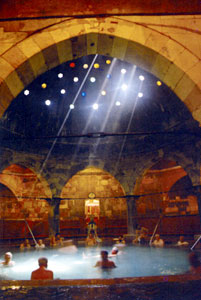| Hungarian
baths,
a real institution
by Justine (Jan 4, 2005)
|
|
Hungary is often well known for its "goulash", but it is also famous for its baths. Baths are a real institution. If you go to Budapest, don't be surprised of seeing many people carrying a plastic bag: they are transporting their swimming belongings. Baths are open from 6 am to 9 pm. Budapestians have been used to going to baths for ages. There are 123 warm springs in Budapest.
|
Open in 1914, Széchenyi baths form the biggest hydropathical complex of Europe. The spring supply ing the pools is so warm that you can bathe outside even in winter. The three main outdoor swimming pools have temperatures of 27, 34 and 38°C!
A massage, a sauna, and of course a shower can finish your bathing. No sooner have you left Széchenyi baths than you feel an impression of well-being, followed by a small hunger. Why not taste typical Hungarian pastries, like the Rčtes or the somtói galuska? |
|
If you wish to react to this article, write to the editor. |
|





